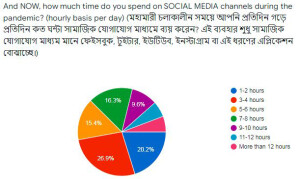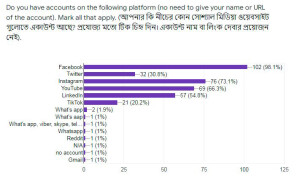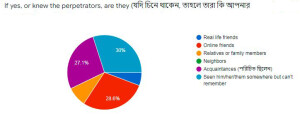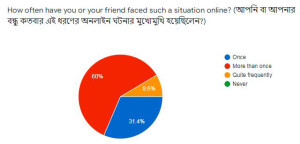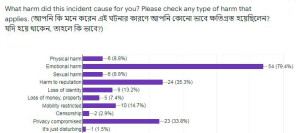
Bytesforall Bangladesh in collaboration with Bangladesh Open Source Network (BDOSN) is happy to share the outcome of its survey that it conducted among more than 100 female Internet users in Bangladesh to map the prevalence, nature, extent, and effect of gender based online violence (GBV) in the country’s online environment. “Online gender-based violence (GBV) takes many forms, including harassment, hacking, impersonation, surveillance/tracking, spamming, the non-consensual distribution of intimate photos and messages, and recruiting victims into violent/harmful situations.” (CIGI/IDRC; 2021*). GBV is often considered to be an important contributing factor in women’s digital exclusion. This survey also aims to compare the prevalence of GBV before and during/after the pandemic and understand the preparedness, response and action from the victims.
Who were the survey participants?
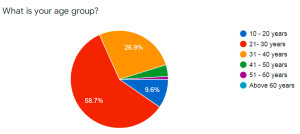 The survey had a random sample size of more than 100 female Internet users who represent various segments of the society. A good number of them were students but there were professionals, entrepreneurs, private & public service holders, housemakers etc. as well. About 58.6% of the respondents were at the age group of 21-30 years followed by 26.9% at the age group of 31-40 years and 9.6% in the 10-20 years age group. Out of these respondents, 8.6% were from minority groups including ethnic, religious, LGBT and/or physical/mental disability groups.
The survey had a random sample size of more than 100 female Internet users who represent various segments of the society. A good number of them were students but there were professionals, entrepreneurs, private & public service holders, housemakers etc. as well. About 58.6% of the respondents were at the age group of 21-30 years followed by 26.9% at the age group of 31-40 years and 9.6% in the 10-20 years age group. Out of these respondents, 8.6% were from minority groups including ethnic, religious, LGBT and/or physical/mental disability groups.
How much time do they spend online?
We tried to map the extent of Internet usage of the respondents in two categories: before and during/after the pandemic. It gave us an opportunity to understand their possibilities of being victim of GBV and the prevalence of such incidents before and after/during the pandemic. 63.4% of the respondents have been using the Internet for 1-4 hours (a day) before the pandemic, which increased many-folded during and after the pandemic. 78.8% of the respondents said that they are using the Internet for more than 4 hours now with some (13.5%) going as much as 12 hours or more a day.
| Before the pandemic | During/after the pandemic |
|---|---|
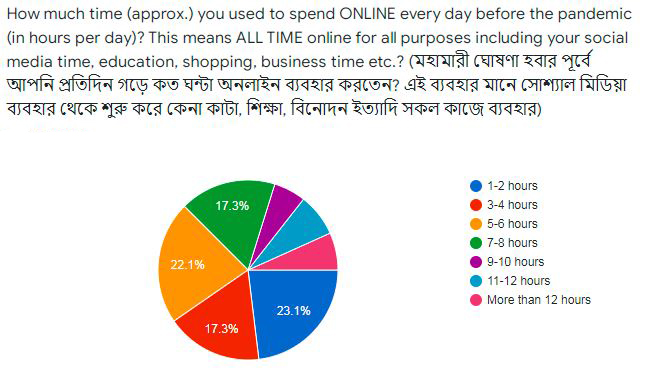 |
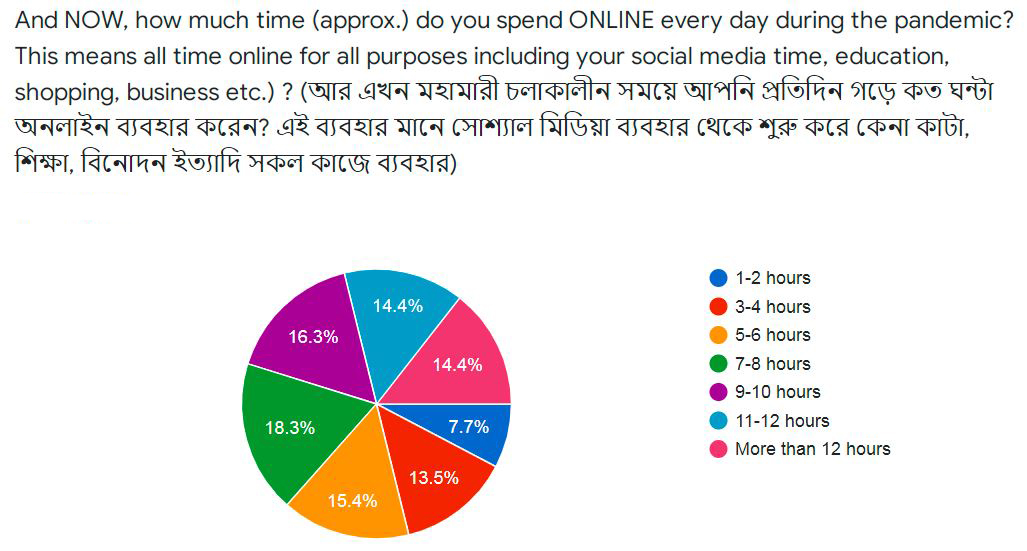 |
A big chunk of this online time goes to social media channels. Therefore, the usage of social media was particularly interesting. Close to 53% of the respondents are spending more than 4 hours of time in different social media channels now (during or after the pandemic).
Facebook continues to be the most popular social media channel among female Internet users. Almost 98.1% respondents do have Facebook accounts followed by Instagram (73.1%), YouTube (66.3%), LinkedIn (54.8%) and Twitter (30.8%).
Do they face gender based online violence (GBV)?
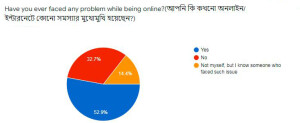 In response to the question, whether they faced any online violence issue or knew of anyone within their network becoming a victim of such violence, there was a resounding ‘YES’ (67.3%). This shows GBV is pretty much a commonplace in Bangladesh online environment.
In response to the question, whether they faced any online violence issue or knew of anyone within their network becoming a victim of such violence, there was a resounding ‘YES’ (67.3%). This shows GBV is pretty much a commonplace in Bangladesh online environment.
Facebook was predominantly the place (98.6%) where they faced such an issue. This was understandable because Facebook was the most commonly used social media platform among female Internet users in Bangladesh.
What exactly happened?
We tried to dig down a bit to understand what exactly happened to them. Among all the issues, impersonating an user and creating fake profiles using personal data/pictures are the most common complaint (40%). It was followed by the fact that many have been repeatedly harassed by someone online through comments, threats, private messages, tagging, trolling etc (37.1%). Sharing and publishing of private data, conversation, pictures, videos without their consent (24.3%) was also a dominant issue that they faced. Some respondents have also informed that they have received and/or seen lots of hate messages targeted to their identities.(21.4%). Following is the percentile representation in terms of answers.
| My private data, conversation, pictures, videos have been accessed: | 11.4% |
| My private data, conversation, pictures, videos have been shared & published without my consent: | 24.3% |
| Some person impersonated me and created fake profiles using my personal data, pictures, videos: | 40% |
| Some people shared, distributed messages, photos, videos and communicated with others using my fake profile: | 20% |
| I have been repeatedly followed, monitored, tracked by someone else: | 20% |
| I have been repeatedly harassed by someone online through comments, threats, private messages, tagging, trolling etc: | 37.1% |
| My social media and email accounts have been hacked, unwanted messages have been posted to my friends, families: | 20% |
| I have been given threat to life, intimidated by sexual violence, rape, blackmailing etc.: | 15.7% |
| Online threat for violence, trolling etc. transformed into offline attack: | 18.6% |
| I have received and/or seen lots of hate messages targeted to my identities. | 21.4% |
We wanted to know whether the respondents knew the perpetrators earlier or not. Only 38.6% informed that they knew the perpetrators. Out of these 30% informed that the perpetrator were their real life friends, 28.6% said they were their online friends.
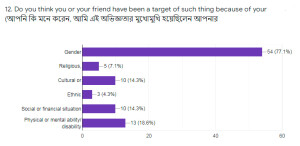
We also wanted to see whether they think their identities have any probability association to the incidents. Majority of them think (77.1%) gender is often an important reason for them to be a victim of online violence. Interestingly, a good number of respondents also think physical/mental disability (18.6%) and socio-financial situation (14.3%) could also be other important factors.
How is the prevalence of gender based online violence before and after/during the pandemic?
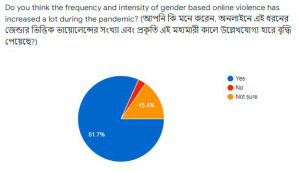 There seems to be an increasing trend of online violence during the period of this pandemic. Almost 42% have responded that they or their friends have experienced gender based online violence during this period of the pandemic. This was also supported by another question, where 81.7% respondents suggest that they think (separate from what they experienced) online violence has increased many fold during this period of pandemic when many people were online for various reasons.
There seems to be an increasing trend of online violence during the period of this pandemic. Almost 42% have responded that they or their friends have experienced gender based online violence during this period of the pandemic. This was also supported by another question, where 81.7% respondents suggest that they think (separate from what they experienced) online violence has increased many fold during this period of pandemic when many people were online for various reasons.
Many respondents (about 68.6%) reported that they faced such a situation more than once in the online environment, which validates that gender based online violence (GBV) is quite frequent.
How does it hurt?
We also wanted to know what harm it has inflicted on the victims as often that is not documented. About 79.4% of the respondents confirmed that this sort of incident caused emotional harm to them, followed by harm to reputation (35.3%) and compromised privacy (33.8%). Some (14.7%) also opined for mobility restriction which is alarming.
What did they do once that happened?
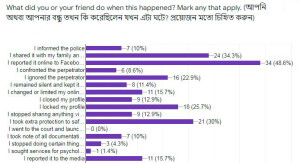 In order to investigate the level of digital preparedness and awareness of cyber safety/ security, we investigated what they did once they or their friends became victims of online violence.
In order to investigate the level of digital preparedness and awareness of cyber safety/ security, we investigated what they did once they or their friends became victims of online violence.
It seems that many of them knew the reporting process of such incidents online and they reported it to the respective social media channels (48.6%). Some even went all the way to report it to the media (15.7%). A small segment (12%) reported it to the police too.
A good number of respondents informed that they shared it with their immediate family and friends (34.3%). But there was a small group (11.4%) who kept this hidden from everyone and remained silent. Some (30%) have taken extra protection to safeguard their social media accounts including changing their passwords etc. 25.7% of them have locked their profiles in social media accounts.
What is alarming though, some (15.7%) have changed or limited their online activities and 12.9% even have closed their profiles forever in their social media accounts. Some of them (12.8%) don’t share anything via their account.
What was interesting to see is that some have confronted the perpetrator online (8.6%) while many have ignored them (22.9%).
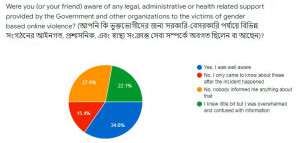 We also wanted to know from the respondents whether they were aware of any support system.
We also wanted to know from the respondents whether they were aware of any support system.
It seems that a big chunk of the respondents were not aware of any government/non-government support system at the time of being victim of such violence. Only 34.6% of respondents were aware of this but the rest (65.4%) were not.
* Source URL: https://www.idrc.ca/en/project/supporting-safer-internet-global-survey-gender-based-violence-online
Feature image credit: Photo by Vlada Karpovich from Pexels (under free license)

